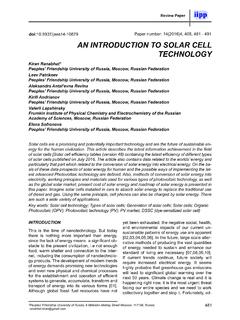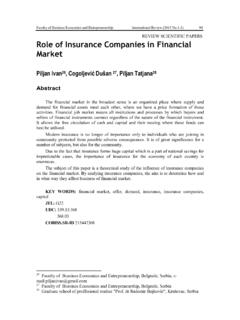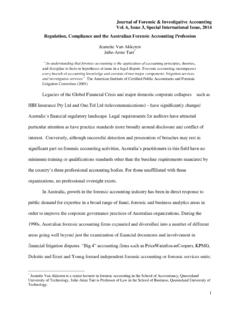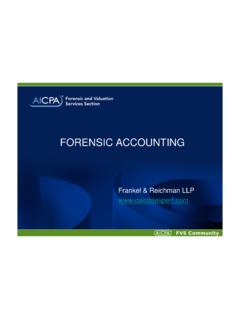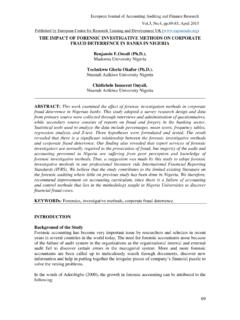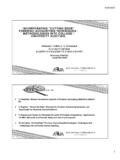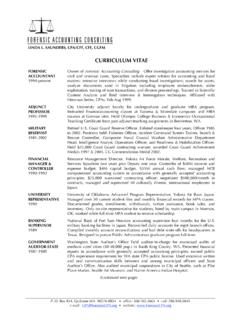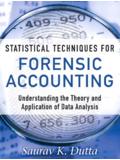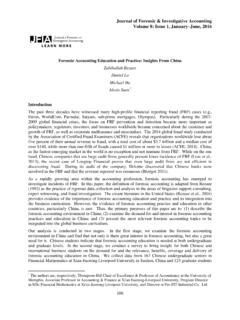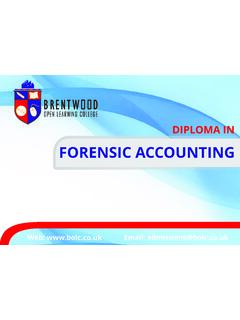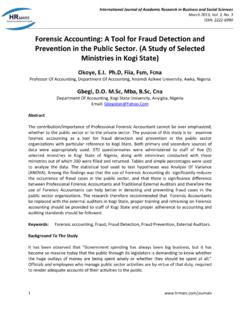Transcription of FORENSIC ACCOUNTING IN THE FRAUD AUDITING CASE
1 45 FORENSIC ACCOUNTING IN THE FRAUD AUDITING CASENata a Simeunovi 1,*, Gojko Grubor2, Nenad Risti 11 University Sinergija, Str. Raje Bani i a bb, Bijeljina, Bosnia and Herzegovina2 Singidunum University,32 Danijelova Street, Belgrade, SerbiaAbstract: This paper presents a real case of digital FORENSIC analysis in or-ganizational FRAUD AUDITING process investigated using two different FORENSIC tools, namely Tableau TD3 Touch Screen FORENSIC Imager and Access Data FTK Imager. FRAUD AUDITING is more of a mindset than a methodology and has different approaches from financial au-diting. FRAUD auditors are mostly focused on exceptions, ACCOUNTING irregularities, and patterns of their conduct. Financial auditors place special emphasis on the audit trail and material misstatements. A FRAUD case investigation of non-cash misappropriations committed by an employee, the warehouseman, will be presented herein in order to highlight the usefulness of FRAUD AUDITING , which can reveal many forms of financial crime and can be used in both private and public sector companies.
2 Due to the computerized ACCOUNTING environment, FRAUD investigation requires a combination of AUDITING , computer crime and digital FORENSIC investigation skills, which can be achieved through joint efforts and cooperation of both digital investigator and FRAUD auditor as proposed words: AUDITING , ACCOUNTING , FRAUD , FORENSIC evidence, digital FORENSIC analysis.* E-mail: 2016, 13(2): 45-56 ISSN 2406-2588 UDK: : paper/Pregledni nau ni radINTRODUCTIONA uditing is a process that enables determining reliability of recorded, classifi ed and summarized fi nancial data. It is necessary due to huge volume of business transactions (IBM, 2013) and complex ACCOUNTING standards. ACCOUNTING diff ers from AUDITING , as a process of recording, classifi cation and summarizing of economic events to help the management make informed decisions based on the sound fi nancial data (Nigrini, 2011). FRAUD , as a criminal off ence, is a generic term that includes surprising, tricking, cunning, and unfair behaviour by which someone else is cheated.
3 Th e only boundaries defi ning it are those that limit human ingenuity to get an advantage through false means or representations. Corporate FRAUD is any FRAUD perpetrated by, for, or against some busi-ness corporation (Singleton & Singleton, 2010). An occupational FRAUD and abuse, or employee FRAUD is: the use of one s occupation for personal gain through deliberate misuse or theft of the employing 46organization s resources or assets (Nigrini, 2011). Occupational FRAUD includes corruption, asset mis-appropriation and fi nancial statement FRAUD . Th e typical organization s loses due to occupational FRAUD are estimated up to 5% of its annual revenues (ACFE, 2016). In this paper, a FRAUD case of non-cash misappropriations is presented. An employee steals inventory from the warehouse in order to sell it and earn extra money. Economic motives are the most common rea-son for committing despite the presence of other reasons such as egocentric, ideological, emotional etc.
4 Essentially, every FRAUD includes motivation, opportunity and rationalization (the FRAUD tri-angle ) (Nigrini, 2011). Many researchers have demonstrated that the FRAUD triangle can be of great help in profi ling employees committing FRAUD (Se-ward, 2011). In the computerized ACCOUNTING envi-ronment, FRAUD could be committed at the input, throughput or output processing phases. How-ever, entering fraudulent data at the input state is the most usual fraudulent behaviour by ordinary employees, including account payables, benefi ts, or expense claims. Frauds within organizations are mainly associated with the absence of internal controls rather than their weaknesses (Singleton & Singleton, 2010). Th e lack of internal control starts from the strength of access control mechanism to computers in the business information system. It is well-known that many passwords selected by users can be easily cracked by the so called dic-tionary attack, even with a laptop and Windows XP operative system within a few seconds.
5 As the password remains the fi rst and the most important authentication method, companies have to devote particular attention to this fi eld. Some international standard recommendations are to select a password with eight or more combined characters (lower and upper case letters, digits and punctuation marks, or other special characters). Th e length of the user-selected password seems to be a more important parameter. User-selected passwords can provide strong protection if some simple rules are applied and the password encoding hash algorithm of the operating system is strong. Th e simple rules for a good password could be as follows: easy-to-remember, hard-to-guess, in unusual language, rather long, regularly changed, not shared with anybody, and without excessively complex struc-ture (Keszthelyi, 2013).However, some sophisticated attacks such as Trojan horse key logger installed into a computer can easily steal any user-selected password online.
6 Th erefore, ACCOUNTING frauds can rather be discov-ered by reactive than proactive measures. Some statistical data show that out of the overall 65% of detected frauds, only 10% are detected by fi nan-cial auditors, while 23% of frauds are identifi ed by means of proactive internal control measures. Proactive FRAUD prevention depends mainly on adequate controls and the appropriate workplace culture including a high level of personal honesty and fair behaviour (Nigrini, 2011). All kinds of FRAUD such as theft , irregularities, white-collar crime, and embezzlement are almost synonymous, but are not identical in terms of crim-inal law. In a legal FRAUD investigation, the intent is the most diffi cult aspect to be proved, because it occurs in one s mind and the proof is becom-ing circumstantial. In the private sector, AUDITING FRAUD can be useful for most cases of fi nancial crime such as: embezzlement; misrepresentations of fi -nancial facts; arson-for-profit; bankruptcy FRAUD ; investment frauds of all manner and deception; bank FRAUD ; kickbacks and commercial bribery; computer frauds; frauds of electronic funds trans-fer (EFT) systems; credit card frauds; and scams and schemes by vendors, suppliers, contractors and customers.
7 In any and all cases, FRAUD must be considered an economic, social and organiza-tional phenomenon (Singleton & Singleton, 2010).Th erefore, modern organizations need to have a forensically ready cloud environment to respond adequately to FORENSIC events and demonstrate compliance with the applicable laws and regula-tions (Elyas et al., 2014).In this FRAUD case, the internal auditor could not detect any irregularities, but remained suspi-cious due to his business experience and previous EJAE 2016 13 (2) 45-56 Simeunovi , N., Grubor, G., Risti , N. FORENSIC ACCOUNTING in the FRAUD AUDITING case47knowledge that the related item was not needed in such quantity. Th erefore, he took the case over to digital FORENSIC examiner. In this paper, the aspects of the digital FORENSIC investigation and analysis of the case are OF SOME PREVIOUS WORKN umerous authors have already elaborated on the methods and techniques of FORENSIC account-ing investigations.
8 According to Nigrini, FORENSIC ACCOUNTING investigation process is described in de-tail. Some advanced techniques such as data min-ing (Panigrahi, 2006) and mathematical models (Panigrahi, 2006; Nigrini, 2009) have also been suggested for the FORENSIC ACCOUNTING investiga-tions process. As regards fi nancial statement audits, the most frequently used tools for examination of client data are Excel, CaseWare IDEA and ACL Soft ware. Traditionally, these and similar tools have been called Computer Assisted Audit Tools and Techniques - CAATTs (Coderre, 2009). Some specifi c data mining tools can disclose patterns of fraudulent data transactions such as unusual entries of transactions, excessively high or low value of a variable, and various fi les of ACCOUNTING transactions or unexplained values of records. Gray & Debreceny (2014) identifi ed specifi c FRAUD and evidence combinations in which the use of data mining would be the most or least eff ective.
9 By tak-ing into consideration FRAUD scheme components defi ned by Gao and Srivastava (2011) and data mining functionality, they proposed a taxonomy that identifi es the most eff ective combinations of those components. Although there isn t much information in the literature on the application of data mining techniques to AUDITING in general and FRAUD detection in particular, some sources need to be mentioned (Jans et al., 2010; Ravisankar et al., 2011; Perols, 2011; Alden et al., 2012). Th e fi rst mathematical model (Th e Benford s Law) sug-gested that fraudulent fi gures have a diff erent pat-tern than the valid ones, while the second model (Th e Relative Size Factor) detects unusual fi gures and data that could be made by errors or frauds (Panigrahi, 2006). However, the growth of big data and belonging technology (IBM, 2013), and the complexity of fi nancial transactions and fraudsters skilfulness are the main problems in FORENSIC ac-counting and FRAUD investigation FORENSIC INVESTIGATION IN FRAUD AUDITING PROCESSD igital FORENSIC investigation, by its nature, is a dichotomy phenomenon; it is as much an art as it is a science.
10 At the same time, it represents both an intuitive process and the formal analytical and scientifi c methodology (Milosavljevi & Grubor, 2010). Th erefore, it is diffi cult to be taught and learned. Similarly, FRAUD AUDITING process depends more on intuition and thinking as a thief would, than on various formally learnt subjects. A digital FORENSIC examiner, like a FRAUD auditor, looks for relevant information without presumption, organ-izes it and tries to discover relevant data and make a pattern they create in order to reconstruct what may have occurred (Singleton & Singleton, 2010; Milosavljevi & Grubor, 2010). Event reconstruc-tion is one of the most important steps in digital investigation. It allows investigators to understand the timeline of a criminal case (Chabot et al., 2014). Also, in the computerized environment, FRAUD auditors should be familiar with relevant legisla-tion, applicable standards and other requirements within the organization.



